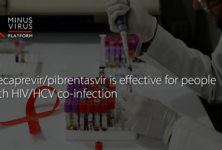Eight weeks of treatment with AbbVie’s investigational, pan-genotypic, ribavirin-free regimen of glecaprevir/pibrentasvir (G/P) for chronic hepatitis C achieved high SVR[12] rates in genotype 1 Japanese patients.
– 99 percent (n=105/106) of genotype 1 (GT1) chronic HCV-infected Japanese patients without cirrhosis achieved SVR[12] with 8 weeks of G/P
– Japan has one of the highest rates of hepatitis C infection in the industrialized world affecting approximately 1 million people, 60 to 70 percent of those GT1[1,2,3]
– Results demonstrated in CERTAIN-1 study are consistent with recently announced 8-week, GT1 data from the global registrational studies for G/P
AbbVie (NYSE: ABBV), a global biopharmaceutical company, today announced high SVR12 rates with 8 weeks of treatment with its investigational, pan-genotypic, ribavirin (RBV)-free regimen of glecaprevir (ABT-493)/pibrentasvir (ABT-530) (G/P) in Japanese patients with genotype 1 (GT1) chronic hepatitis C virus (HCV) infection without cirrhosis. In top-line results from the Phase 3 CERTAIN-1 study, 99 percent (n=105/106) of patients without cirrhosis, which represents the majority of HCV patients, and without the Y93H variant achieved sustained virologic response at 12 weeks post treatment (SVR12). The only patient in whom SVR12 was not documented in this intent to treat (ITT) population was lost to follow-up. All 23 patients with the Y93H variant were assigned to the G/P arm and achieved SVR12.
These data are the first to be released from registrational studies in Japan as part of AbbVie’s global G/P clinical development program, designed to investigate a faster path to virologic cure* for all major HCV genotypes and with the goal of addressing treatment areas of continued unmet need.
“These initial data in GT1-infected patients, which is the most common type of hepatitis C in Japan, may help to further advance our understanding on how we care for patients in this country,” said Stefan Zeuzem, M.D., Chief of the Department of Medicine at the Goethe University Hospital in Frankfurt, Germany. “In the CERTAIN-1 study with the G/P regimen, we see for the first time that 8 weeks of treatment achieved high cure rates in these GT1-infected Japanese patients without cirrhosis.”
Japan has one of the highest rates of hepatitis C infection in the industrialized world.2 Approximately 1 million people are living with hepatitis C in Japan, with 60 to 70 percent of those infected with GT1 chronic HCV.1,3 Patients included in the CERTAIN-1 study were further representative of the HCV-infected patient population in Japan, where the prevalence of HCV infection increases with age, by including a majority of patients over 65 years of age.4
“Due to patient characteristics and virological considerations, people living with HCV in Japan have specific treatment challenges and needs,” said Michael Severino, M.D., executive vice president, research and development and chief scientific officer, AbbVie. “AbbVie’s dedicated G/P registrational clinical development program in Japan reflects our continued commitment to make a real difference in the lives of Japanese patients.”
The CERTAIN-1 study compared the safety and efficacy of 8 weeks of treatment with the investigational G/P regimen, to 12 weeks of ombitasvir/paritaprevir/ritonavir (OBV/PTV/r), in GT1 chronic HCV-infected patients. The primary endpoint of the study was met, as 8 weeks of G/P was shown to be non-inferior to 12 weeks of OBV/PTV/r (100 percent SVR12; n=52).
Additionally, in substudy 1 evaluating GT1 patients (treated with G/P) without cirrhosis and who are new to treatment with direct-acting antivirals (DAA), no patients discontinued treatment due to adverse events (AEs). In patients treated with OBV/PTV/r, there was one who discontinued treatment due to AEs. In patients receiving the G/P regimen, the most common AEs, occurring at a rate greater than 5 percent, were nasopharyngitis (inflammation of the throat and nasal passages) and pruritus (itchiness).
About the CERTAIN-1 Study
The CERTAIN-1 study is a Phase 3, multicenter study evaluating the efficacy, safety and pharmacokinetics (PK) of G/P in Japanese adults. Substudy 1 is randomized, open-label, active-controlled, in genotype 1 (GT1) chronic HCV-infected patients without cirrhosis and who are new to DAA treatment. Patients who tested negative for Y93H resistance associated variant received either 8 weeks of G/P or 12 weeks of OBV/PTV/r (2:1 randomization ratio). All Y93H positive patients were assigned to receive 8 weeks of G/P and all (n=23/23) achieved SVR12. The primary objectives were safety and non-inferiority of G/P compared to OBV/PTV/r.
Substudy 2 is a non-randomized, open-label study evaluating GT1-6 HCV patients with specific treatment challenges, including those with compensated cirrhosis (Child-Pugh A), chronic kidney disease (CKD) and those who were not cured with previous DAA treatment.
Additional data will be presented at an upcoming scientific congress.
About AbbVie’s G/P Clinical Development Program
AbbVie’s glecaprevir/pibrentasvir (G/P) clinical development program was designed to investigate a faster path to virologic cure* for all major HCV genotypes (GT1-6) and with the goal of addressing treatment areas of continued unmet need. In Japan, AbbVie studied the G/P regimen in additional dedicated clinical trials due to patient and viral characteristics specific to the Japanese HCV patient population.
G/P is an investigational, pan-genotypic regimen that is being evaluated as a potential cure in 8 weeks for HCV patients without cirrhosis and who are new to treatment with direct-acting antivirals (DAA), who make up the majority of HCV patients. AbbVie is also studying G/P in patients with specific treatment challenges, such as genotype 3, patients who were not cured with previous DAA treatment and those with chronic kidney disease, including patients on dialysis.
G/P is an investigational, once-daily regimen that combines two distinct antiviral agents in a fixed-dose combination of glecaprevir (300mg), an NS3/4A protease inhibitor, and pibrentasvir (120mg), an NS5A inhibitor. G/P is dosed once-daily as three oral tablets.
Glecaprevir (GLE) was discovered during the ongoing collaboration between AbbVie and Enanta Pharmaceuticals (NASDAQ: ENTA) for HCV protease inhibitors and regimens that include protease inhibitors.
G/P is an investigational product and its safety and efficacy have not been established in Japan.
*Patients with a sustained virologic response at 12 weeks post treatment (SVR12) are considered cured of hepatitis C.
About VIEKIRAX in Japan
VIEKIRAX (ombitasvir/paritaprevir/ritonavir) is indicated for the improvement of viremia in chronic hepatitis C or compensated hepatic cirrhosis C in patients of serogroup 1 (genotype 1) and for chronic hepatitis C in patients of serogroup 2 (genotype 2).
Summary of Safety Information
Contraindications
VIEKIRAX is contraindicated in patients with a history of known hypersensitivity to an ingredient in VIEKIRAX, patients with moderate and more severe hepatic impairment (Child-Pugh B and C) or patients being treated with the following drugs: azelnidipine, triazolam, iv midazolam, blonanserin, pimozide, ergotamine tartrate, dihydroergotamine mesilate, ergometrine maleate, methylergometrine maleate, sildenafil citrate [Revatio], tadalafil [Adcirca], rivaroxaban, vardenafil hydrochloride hydrate, riociguat, simvastatin, atorvastatin calcium hydrate, carbamazepine, phenytoin, fosphenytoin sodium hydrate, phenobarbital, rifampin, efavirenz, foods containing St. John’s Wort (Hypericum perforatum), ethinyl estradiol-containing medicinal products. Patients receiving colchicine with renal or hepatic impairment.
Precautions for Use
Positive result for HCV RNA should be confirmed before administering VIEKIRAX and decompensated cirrhosis should be excluded.
For genotype 2, since efficacy varies due to subtype and prior treatment experience with or without IFN the benefit-risk of VIEKIRAX treatment should be considered. Since VIEKIRAX is coadministered with ribavirin in genotype 2, precautions for use of the package insert of ribavirin must be confirmed.
When VIEKIRAX is used for patients co-infected with HIV/HCV, administer VIEKIRAX only to patients whose virological suppression has been achieved by anti-HIV therapy as ritonavir may cause resistance against a HIV protease inhibitor.
During the administration of VIEKIRAX, perform liver function tests regularly because hepatic function disorder may occur.
While HCV viral load is decreased, HBV reactivation in patients who are chronic infection of HBV or patients who have a history of HBV infection has been reported after initiation of HCV DAA treatment.
Renal function tests should be performed prior to an initiation and periodically after initiation of VIEKIRAX.
Co-administration of VIEKIRAX with drugs that are substrates of CYP3A4, P-gp, BCRP, OATP1B1 or OATP1B3 may result in increased plasma concentrations of such drugs, potentially requiring dose adjustment or clinical monitoring.
The safety of VIEKIRAX in pregnant women has not been established. VIEKIRAX should be used in pregnant women and women who may possibly be pregnant only if the expected therapeutic benefits outweigh the possible risks associated with treatment. VIEKIRAX in combination with ribavirin must not be used in patients who are pregnant or may be pregnant.
Do not administer VIEKIRAX to nursing mothers. If VIEKIRAX is administered to a nursing mother by necessity, breast feeding must be discontinued during treatment.
Safety and effectiveness have not been established in children.
Adverse Reactions
Common adverse reactions in Phase 3 clinical trials of VIEKIRAX in Japan in GT1b patients included peripheral edema in 15 subjects (4.1%), headache in 12 subjects (3.3%) and nausea in 10 subjects (2.8%); and anemia in 36 subjects (22.5%), blood bilirubin increased in 29 subjects (18.1%) and pruritus in 14 subjects (8.8%) in GT2 patients.
About AbbVie
AbbVie is a global, research-based biopharmaceutical company formed in 2013 following separation from Abbott Laboratories. The company’s mission is to use its expertise, dedicated people and unique approach to innovation to develop and market advanced therapies that address some of the world’s most complex and serious diseases. Together with its wholly-owned subsidiary, Pharmacyclics, AbbVie employs more than 28,000 people worldwide and markets medicines in more than 170 countries. For further information on the company and its people, portfolio and commitments, please visit www.abbvie.com. Follow @abbvie on Twitter or view careers on our Facebook or LinkedIn page.
Forward-Looking Statements
Some statements in this news release may be forward-looking statements for purposes of the Private Securities Litigation Reform Act of 1995. The words “believe,” “expect,” “anticipate,” “project” and similar expressions, among others, generally identify forward-looking statements. AbbVie cautions that these forward-looking statements are subject to risks and uncertainties that may cause actual results to differ materially from those indicated in the forward-looking statements. Such risks and uncertainties include, but are not limited to, challenges to intellectual property, competition from other products, difficulties inherent in the research and development process, adverse litigation or government action, and changes to laws and regulations applicable to our industry.
Additional information about the economic, competitive, governmental, technological and other factors that may affect AbbVie’s operations is set forth in Item 1A, “Risk Factors,” of AbbVie’s 2015 Annual Report on Form 10-K, which has been filed with the Securities and Exchange Commission. AbbVie undertakes no obligation to release publicly any revisions to forward-looking statements as a result of subsequent events or developments, except as required by law.
1 National Center for Global Health and Medicine. Hepatitis C. Assessed January 2017. Available from: http://www.kanen.ncgm.go.jp/cont/010/c_gata.html
2 Gower, E. Global epidemiology and genotype distribution of the hepatitis C virus infection. Journal of Hepatology 2014; 61: S45-S57, Table 2.
3 Hajarizadeh B et al. Nat Rev Gastroenterol Hepatol 2013; 10: 553-562. Available from: http://www.nature.com/nrgastro/journal/v10/n9/fig_tab/nrgastro.2013.107_F1.html
4 Chung H, Taisuke U, Masatoshi K. Changing Trends in Hepatitis C Infection over the Past 50 Years in Japan. Intervirology 2010; 53:39–43.


 ПОИСК ПО САЙТУ
ПОИСК ПО САЙТУ  поиск по ресурсному центру
поиск по ресурсному центру 



